Corporate Social Responsibility and Employee Retention: M&S Case Study
VerifiedAdded on 2020/12/30
|39
|9429
|275
Report
AI Summary
This report analyzes employee retention strategies at Marks & Spencer (M&S), a major UK-based retail company, focusing on the application of corporate social responsibility (CSR). The study, employing an interpretivism philosophy and a descriptive research design, investigates the challenges M&S faces regarding employee retention. Data collection involved questionnaires distributed to employees, exploring determinants of retention, the impact of CSR practices, and associated challenges. The research aims to determine the factors that influence employee retention and how CSR can be used to increase employee retention by 5% within 6 months. Key findings suggest that flexible working conditions and development opportunities positively influence employee commitment. The report concludes with recommendations for M&S to improve retention through CSR initiatives, offering insights into the importance of employee satisfaction and retention for business success.
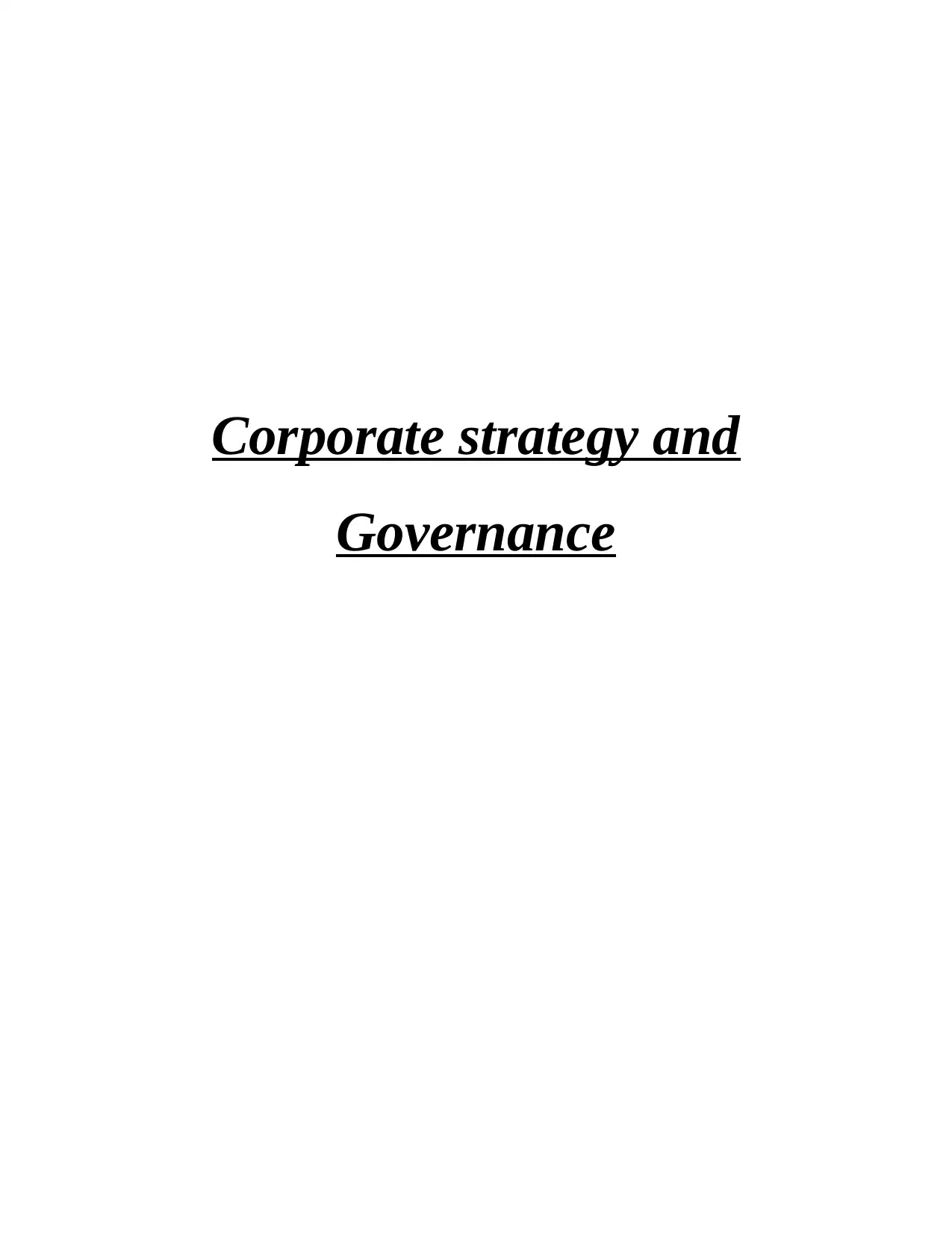
Corporate strategy and
Governance
Governance
Paraphrase This Document
Need a fresh take? Get an instant paraphrase of this document with our AI Paraphraser
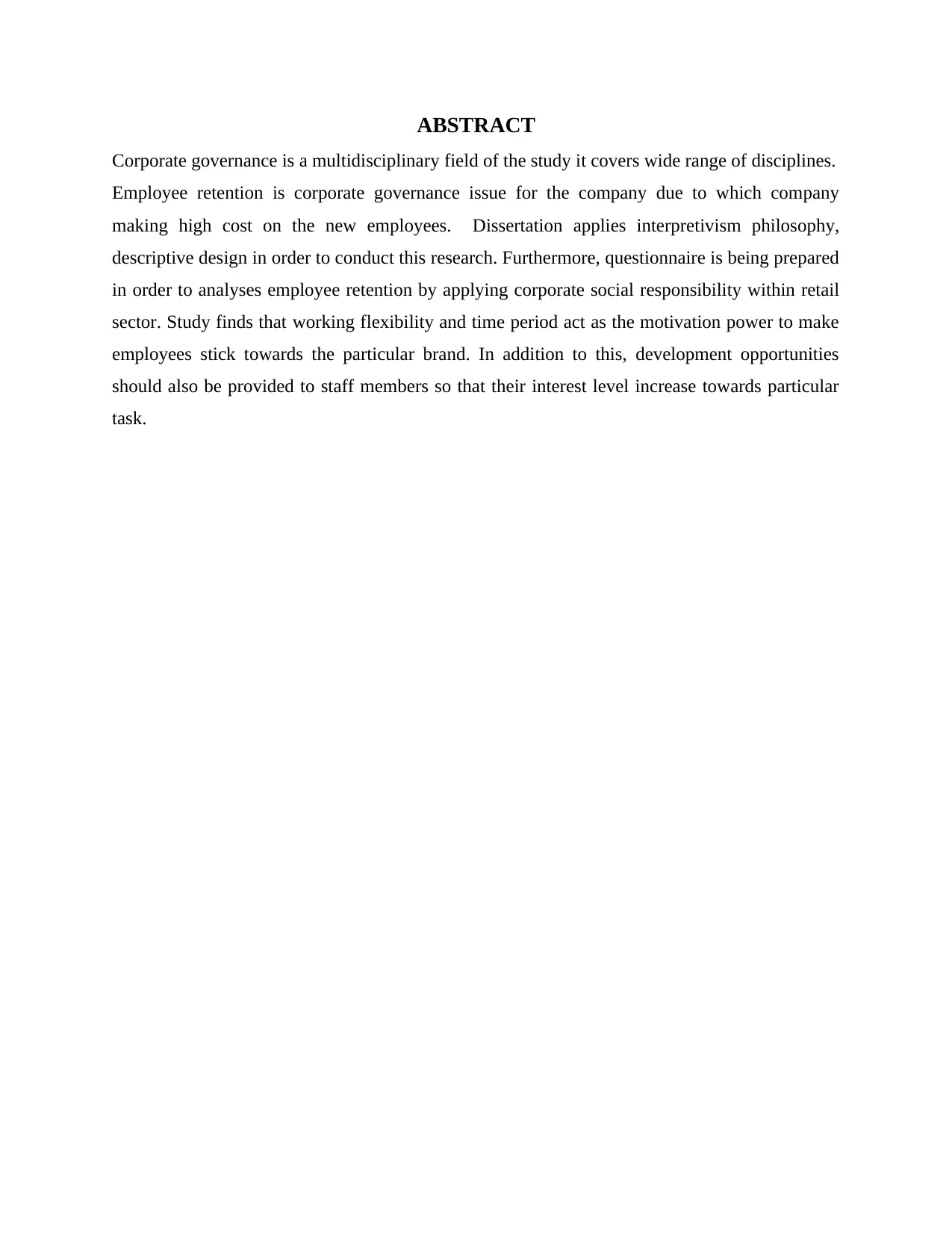
ABSTRACT
Corporate governance is a multidisciplinary field of the study it covers wide range of disciplines.
Employee retention is corporate governance issue for the company due to which company
making high cost on the new employees. Dissertation applies interpretivism philosophy,
descriptive design in order to conduct this research. Furthermore, questionnaire is being prepared
in order to analyses employee retention by applying corporate social responsibility within retail
sector. Study finds that working flexibility and time period act as the motivation power to make
employees stick towards the particular brand. In addition to this, development opportunities
should also be provided to staff members so that their interest level increase towards particular
task.
Corporate governance is a multidisciplinary field of the study it covers wide range of disciplines.
Employee retention is corporate governance issue for the company due to which company
making high cost on the new employees. Dissertation applies interpretivism philosophy,
descriptive design in order to conduct this research. Furthermore, questionnaire is being prepared
in order to analyses employee retention by applying corporate social responsibility within retail
sector. Study finds that working flexibility and time period act as the motivation power to make
employees stick towards the particular brand. In addition to this, development opportunities
should also be provided to staff members so that their interest level increase towards particular
task.
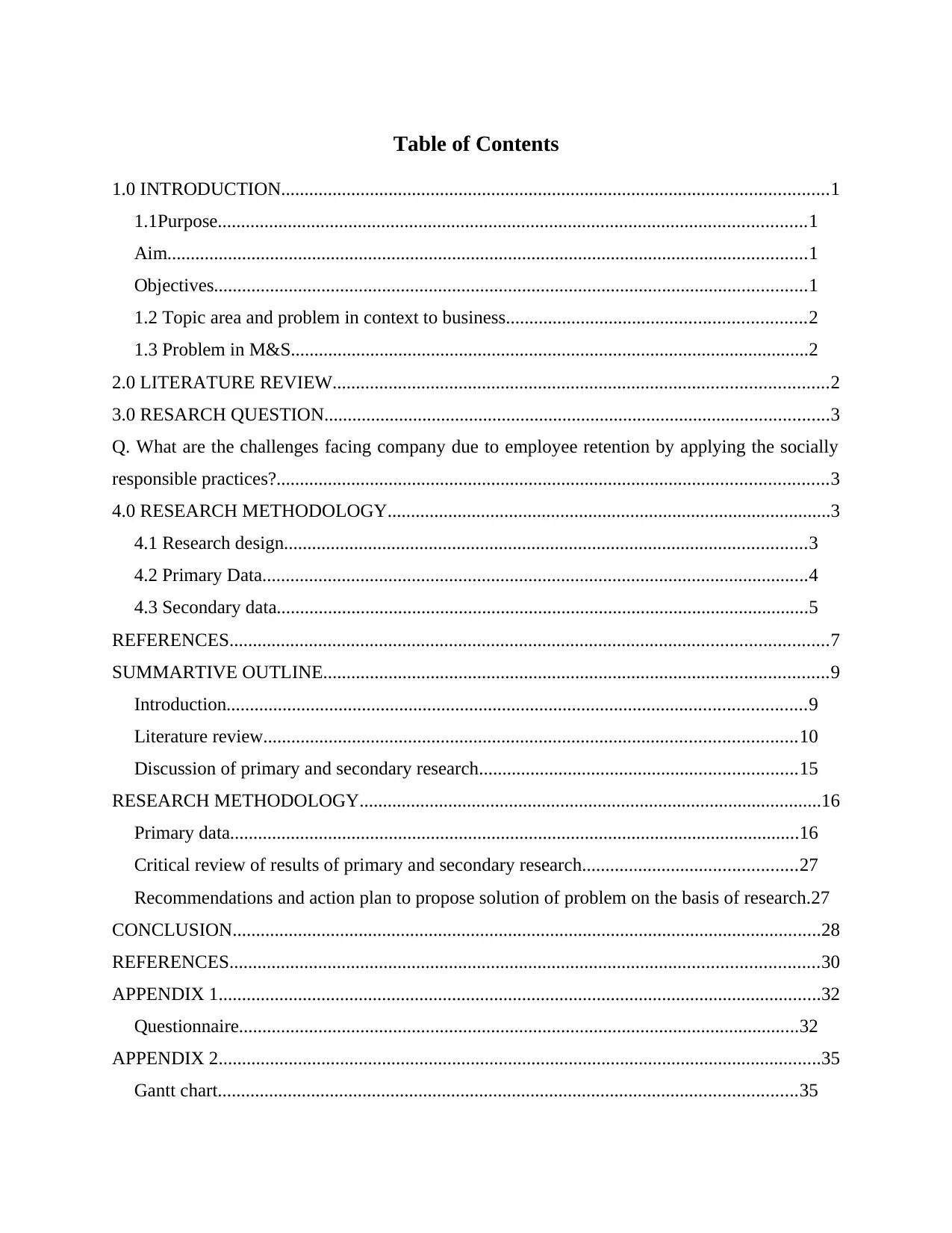
Table of Contents
1.0 INTRODUCTION.....................................................................................................................1
1.1Purpose..............................................................................................................................1
Aim.........................................................................................................................................1
Objectives...............................................................................................................................1
1.2 Topic area and problem in context to business................................................................2
1.3 Problem in M&S...............................................................................................................2
2.0 LITERATURE REVIEW..........................................................................................................2
3.0 RESARCH QUESTION............................................................................................................3
Q. What are the challenges facing company due to employee retention by applying the socially
responsible practices?......................................................................................................................3
4.0 RESEARCH METHODOLOGY...............................................................................................3
4.1 Research design................................................................................................................3
4.2 Primary Data.....................................................................................................................4
4.3 Secondary data..................................................................................................................5
REFERENCES................................................................................................................................7
SUMMARTIVE OUTLINE............................................................................................................9
Introduction............................................................................................................................9
Literature review..................................................................................................................10
Discussion of primary and secondary research....................................................................15
RESEARCH METHODOLOGY...................................................................................................16
Primary data..........................................................................................................................16
Critical review of results of primary and secondary research..............................................27
Recommendations and action plan to propose solution of problem on the basis of research.27
CONCLUSION..............................................................................................................................28
REFERENCES..............................................................................................................................30
APPENDIX 1.................................................................................................................................32
Questionnaire........................................................................................................................32
APPENDIX 2.................................................................................................................................35
Gantt chart............................................................................................................................35
1.0 INTRODUCTION.....................................................................................................................1
1.1Purpose..............................................................................................................................1
Aim.........................................................................................................................................1
Objectives...............................................................................................................................1
1.2 Topic area and problem in context to business................................................................2
1.3 Problem in M&S...............................................................................................................2
2.0 LITERATURE REVIEW..........................................................................................................2
3.0 RESARCH QUESTION............................................................................................................3
Q. What are the challenges facing company due to employee retention by applying the socially
responsible practices?......................................................................................................................3
4.0 RESEARCH METHODOLOGY...............................................................................................3
4.1 Research design................................................................................................................3
4.2 Primary Data.....................................................................................................................4
4.3 Secondary data..................................................................................................................5
REFERENCES................................................................................................................................7
SUMMARTIVE OUTLINE............................................................................................................9
Introduction............................................................................................................................9
Literature review..................................................................................................................10
Discussion of primary and secondary research....................................................................15
RESEARCH METHODOLOGY...................................................................................................16
Primary data..........................................................................................................................16
Critical review of results of primary and secondary research..............................................27
Recommendations and action plan to propose solution of problem on the basis of research.27
CONCLUSION..............................................................................................................................28
REFERENCES..............................................................................................................................30
APPENDIX 1.................................................................................................................................32
Questionnaire........................................................................................................................32
APPENDIX 2.................................................................................................................................35
Gantt chart............................................................................................................................35
⊘ This is a preview!⊘
Do you want full access?
Subscribe today to unlock all pages.

Trusted by 1+ million students worldwide

Paraphrase This Document
Need a fresh take? Get an instant paraphrase of this document with our AI Paraphraser
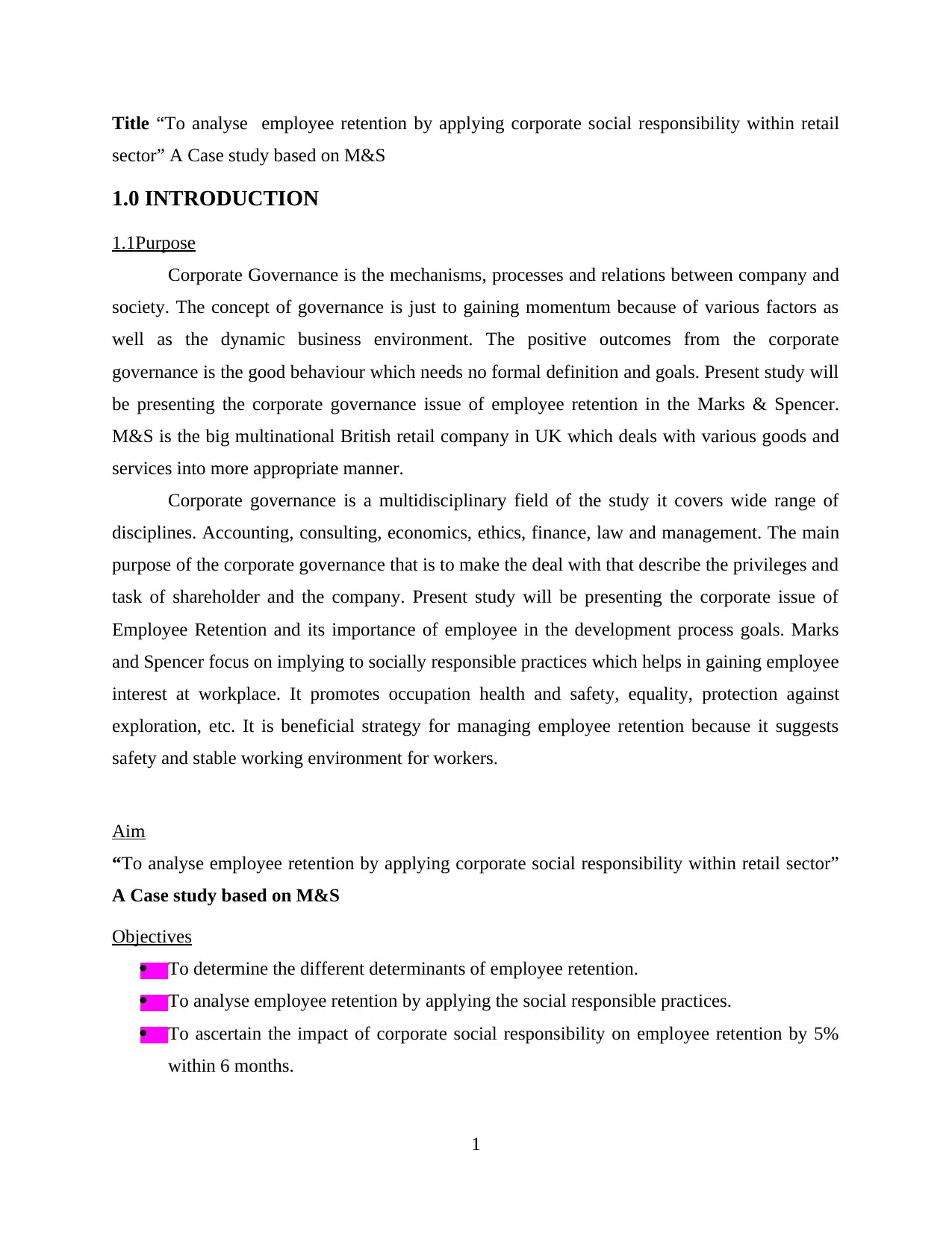
Title “To analyse employee retention by applying corporate social responsibility within retail
sector” A Case study based on M&S
1.0 INTRODUCTION
1.1Purpose
Corporate Governance is the mechanisms, processes and relations between company and
society. The concept of governance is just to gaining momentum because of various factors as
well as the dynamic business environment. The positive outcomes from the corporate
governance is the good behaviour which needs no formal definition and goals. Present study will
be presenting the corporate governance issue of employee retention in the Marks & Spencer.
M&S is the big multinational British retail company in UK which deals with various goods and
services into more appropriate manner.
Corporate governance is a multidisciplinary field of the study it covers wide range of
disciplines. Accounting, consulting, economics, ethics, finance, law and management. The main
purpose of the corporate governance that is to make the deal with that describe the privileges and
task of shareholder and the company. Present study will be presenting the corporate issue of
Employee Retention and its importance of employee in the development process goals. Marks
and Spencer focus on implying to socially responsible practices which helps in gaining employee
interest at workplace. It promotes occupation health and safety, equality, protection against
exploration, etc. It is beneficial strategy for managing employee retention because it suggests
safety and stable working environment for workers.
Aim
“To analyse employee retention by applying corporate social responsibility within retail sector”
A Case study based on M&S
Objectives
To determine the different determinants of employee retention.
To analyse employee retention by applying the social responsible practices.
To ascertain the impact of corporate social responsibility on employee retention by 5%
within 6 months.
1
sector” A Case study based on M&S
1.0 INTRODUCTION
1.1Purpose
Corporate Governance is the mechanisms, processes and relations between company and
society. The concept of governance is just to gaining momentum because of various factors as
well as the dynamic business environment. The positive outcomes from the corporate
governance is the good behaviour which needs no formal definition and goals. Present study will
be presenting the corporate governance issue of employee retention in the Marks & Spencer.
M&S is the big multinational British retail company in UK which deals with various goods and
services into more appropriate manner.
Corporate governance is a multidisciplinary field of the study it covers wide range of
disciplines. Accounting, consulting, economics, ethics, finance, law and management. The main
purpose of the corporate governance that is to make the deal with that describe the privileges and
task of shareholder and the company. Present study will be presenting the corporate issue of
Employee Retention and its importance of employee in the development process goals. Marks
and Spencer focus on implying to socially responsible practices which helps in gaining employee
interest at workplace. It promotes occupation health and safety, equality, protection against
exploration, etc. It is beneficial strategy for managing employee retention because it suggests
safety and stable working environment for workers.
Aim
“To analyse employee retention by applying corporate social responsibility within retail sector”
A Case study based on M&S
Objectives
To determine the different determinants of employee retention.
To analyse employee retention by applying the social responsible practices.
To ascertain the impact of corporate social responsibility on employee retention by 5%
within 6 months.
1
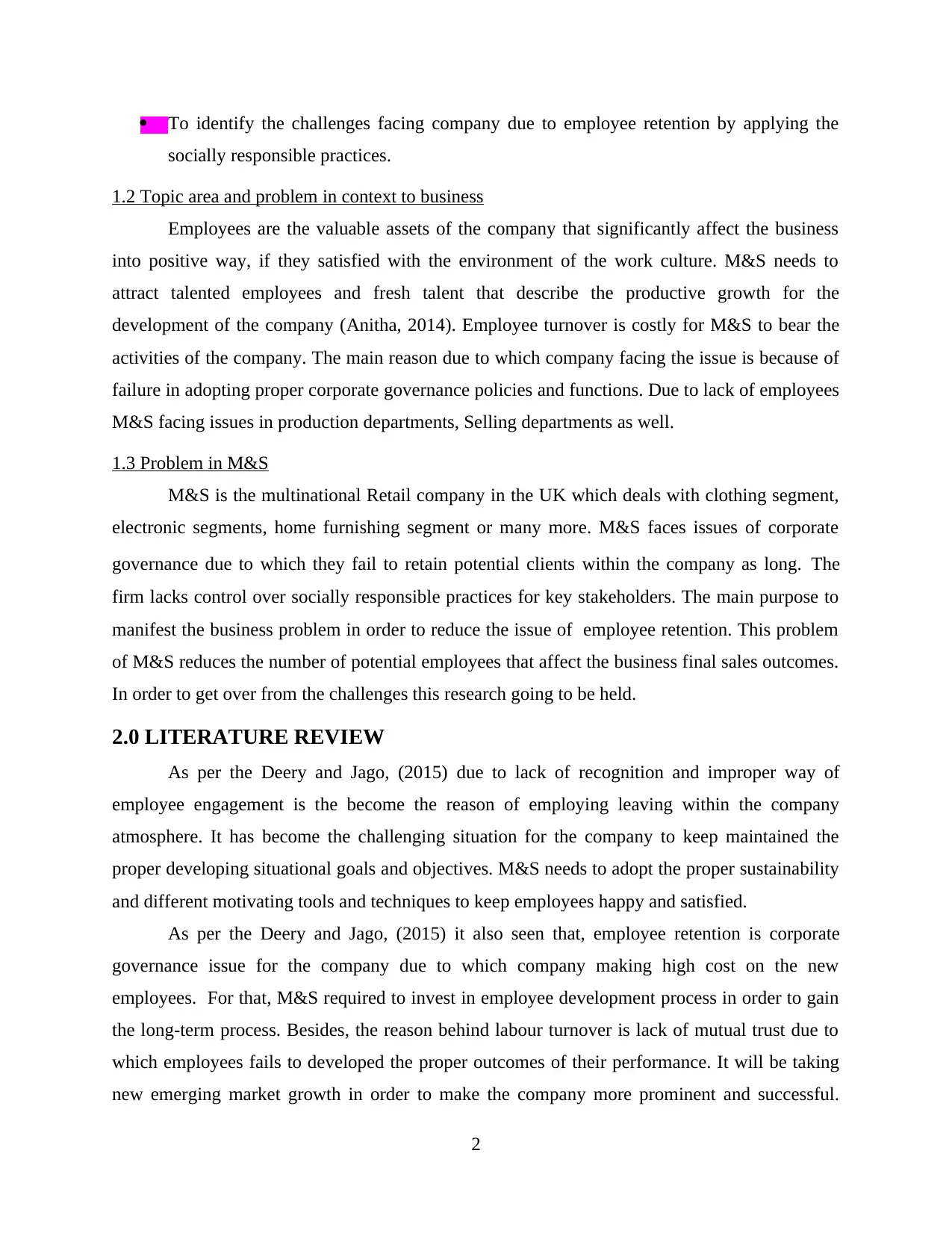
To identify the challenges facing company due to employee retention by applying the
socially responsible practices.
1.2 Topic area and problem in context to business
Employees are the valuable assets of the company that significantly affect the business
into positive way, if they satisfied with the environment of the work culture. M&S needs to
attract talented employees and fresh talent that describe the productive growth for the
development of the company (Anitha, 2014). Employee turnover is costly for M&S to bear the
activities of the company. The main reason due to which company facing the issue is because of
failure in adopting proper corporate governance policies and functions. Due to lack of employees
M&S facing issues in production departments, Selling departments as well.
1.3 Problem in M&S
M&S is the multinational Retail company in the UK which deals with clothing segment,
electronic segments, home furnishing segment or many more. M&S faces issues of corporate
governance due to which they fail to retain potential clients within the company as long. The
firm lacks control over socially responsible practices for key stakeholders. The main purpose to
manifest the business problem in order to reduce the issue of employee retention. This problem
of M&S reduces the number of potential employees that affect the business final sales outcomes.
In order to get over from the challenges this research going to be held.
2.0 LITERATURE REVIEW
As per the Deery and Jago, (2015) due to lack of recognition and improper way of
employee engagement is the become the reason of employing leaving within the company
atmosphere. It has become the challenging situation for the company to keep maintained the
proper developing situational goals and objectives. M&S needs to adopt the proper sustainability
and different motivating tools and techniques to keep employees happy and satisfied.
As per the Deery and Jago, (2015) it also seen that, employee retention is corporate
governance issue for the company due to which company making high cost on the new
employees. For that, M&S required to invest in employee development process in order to gain
the long-term process. Besides, the reason behind labour turnover is lack of mutual trust due to
which employees fails to developed the proper outcomes of their performance. It will be taking
new emerging market growth in order to make the company more prominent and successful.
2
socially responsible practices.
1.2 Topic area and problem in context to business
Employees are the valuable assets of the company that significantly affect the business
into positive way, if they satisfied with the environment of the work culture. M&S needs to
attract talented employees and fresh talent that describe the productive growth for the
development of the company (Anitha, 2014). Employee turnover is costly for M&S to bear the
activities of the company. The main reason due to which company facing the issue is because of
failure in adopting proper corporate governance policies and functions. Due to lack of employees
M&S facing issues in production departments, Selling departments as well.
1.3 Problem in M&S
M&S is the multinational Retail company in the UK which deals with clothing segment,
electronic segments, home furnishing segment or many more. M&S faces issues of corporate
governance due to which they fail to retain potential clients within the company as long. The
firm lacks control over socially responsible practices for key stakeholders. The main purpose to
manifest the business problem in order to reduce the issue of employee retention. This problem
of M&S reduces the number of potential employees that affect the business final sales outcomes.
In order to get over from the challenges this research going to be held.
2.0 LITERATURE REVIEW
As per the Deery and Jago, (2015) due to lack of recognition and improper way of
employee engagement is the become the reason of employing leaving within the company
atmosphere. It has become the challenging situation for the company to keep maintained the
proper developing situational goals and objectives. M&S needs to adopt the proper sustainability
and different motivating tools and techniques to keep employees happy and satisfied.
As per the Deery and Jago, (2015) it also seen that, employee retention is corporate
governance issue for the company due to which company making high cost on the new
employees. For that, M&S required to invest in employee development process in order to gain
the long-term process. Besides, the reason behind labour turnover is lack of mutual trust due to
which employees fails to developed the proper outcomes of their performance. It will be taking
new emerging market growth in order to make the company more prominent and successful.
2
⊘ This is a preview!⊘
Do you want full access?
Subscribe today to unlock all pages.

Trusted by 1+ million students worldwide
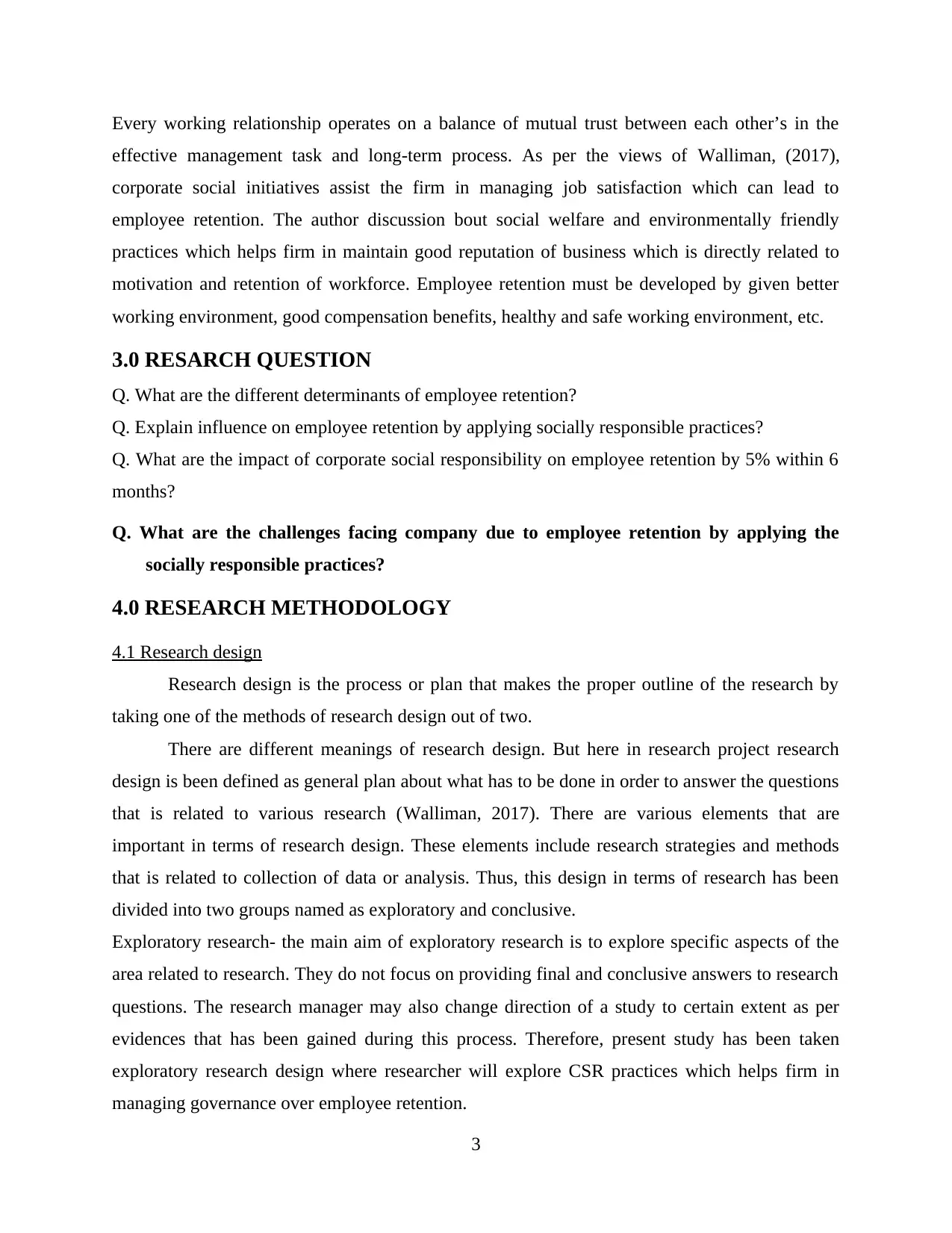
Every working relationship operates on a balance of mutual trust between each other’s in the
effective management task and long-term process. As per the views of Walliman, (2017),
corporate social initiatives assist the firm in managing job satisfaction which can lead to
employee retention. The author discussion bout social welfare and environmentally friendly
practices which helps firm in maintain good reputation of business which is directly related to
motivation and retention of workforce. Employee retention must be developed by given better
working environment, good compensation benefits, healthy and safe working environment, etc.
3.0 RESARCH QUESTION
Q. What are the different determinants of employee retention?
Q. Explain influence on employee retention by applying socially responsible practices?
Q. What are the impact of corporate social responsibility on employee retention by 5% within 6
months?
Q. What are the challenges facing company due to employee retention by applying the
socially responsible practices?
4.0 RESEARCH METHODOLOGY
4.1 Research design
Research design is the process or plan that makes the proper outline of the research by
taking one of the methods of research design out of two.
There are different meanings of research design. But here in research project research
design is been defined as general plan about what has to be done in order to answer the questions
that is related to various research (Walliman, 2017). There are various elements that are
important in terms of research design. These elements include research strategies and methods
that is related to collection of data or analysis. Thus, this design in terms of research has been
divided into two groups named as exploratory and conclusive.
Exploratory research- the main aim of exploratory research is to explore specific aspects of the
area related to research. They do not focus on providing final and conclusive answers to research
questions. The research manager may also change direction of a study to certain extent as per
evidences that has been gained during this process. Therefore, present study has been taken
exploratory research design where researcher will explore CSR practices which helps firm in
managing governance over employee retention.
3
effective management task and long-term process. As per the views of Walliman, (2017),
corporate social initiatives assist the firm in managing job satisfaction which can lead to
employee retention. The author discussion bout social welfare and environmentally friendly
practices which helps firm in maintain good reputation of business which is directly related to
motivation and retention of workforce. Employee retention must be developed by given better
working environment, good compensation benefits, healthy and safe working environment, etc.
3.0 RESARCH QUESTION
Q. What are the different determinants of employee retention?
Q. Explain influence on employee retention by applying socially responsible practices?
Q. What are the impact of corporate social responsibility on employee retention by 5% within 6
months?
Q. What are the challenges facing company due to employee retention by applying the
socially responsible practices?
4.0 RESEARCH METHODOLOGY
4.1 Research design
Research design is the process or plan that makes the proper outline of the research by
taking one of the methods of research design out of two.
There are different meanings of research design. But here in research project research
design is been defined as general plan about what has to be done in order to answer the questions
that is related to various research (Walliman, 2017). There are various elements that are
important in terms of research design. These elements include research strategies and methods
that is related to collection of data or analysis. Thus, this design in terms of research has been
divided into two groups named as exploratory and conclusive.
Exploratory research- the main aim of exploratory research is to explore specific aspects of the
area related to research. They do not focus on providing final and conclusive answers to research
questions. The research manager may also change direction of a study to certain extent as per
evidences that has been gained during this process. Therefore, present study has been taken
exploratory research design where researcher will explore CSR practices which helps firm in
managing governance over employee retention.
3
Paraphrase This Document
Need a fresh take? Get an instant paraphrase of this document with our AI Paraphraser
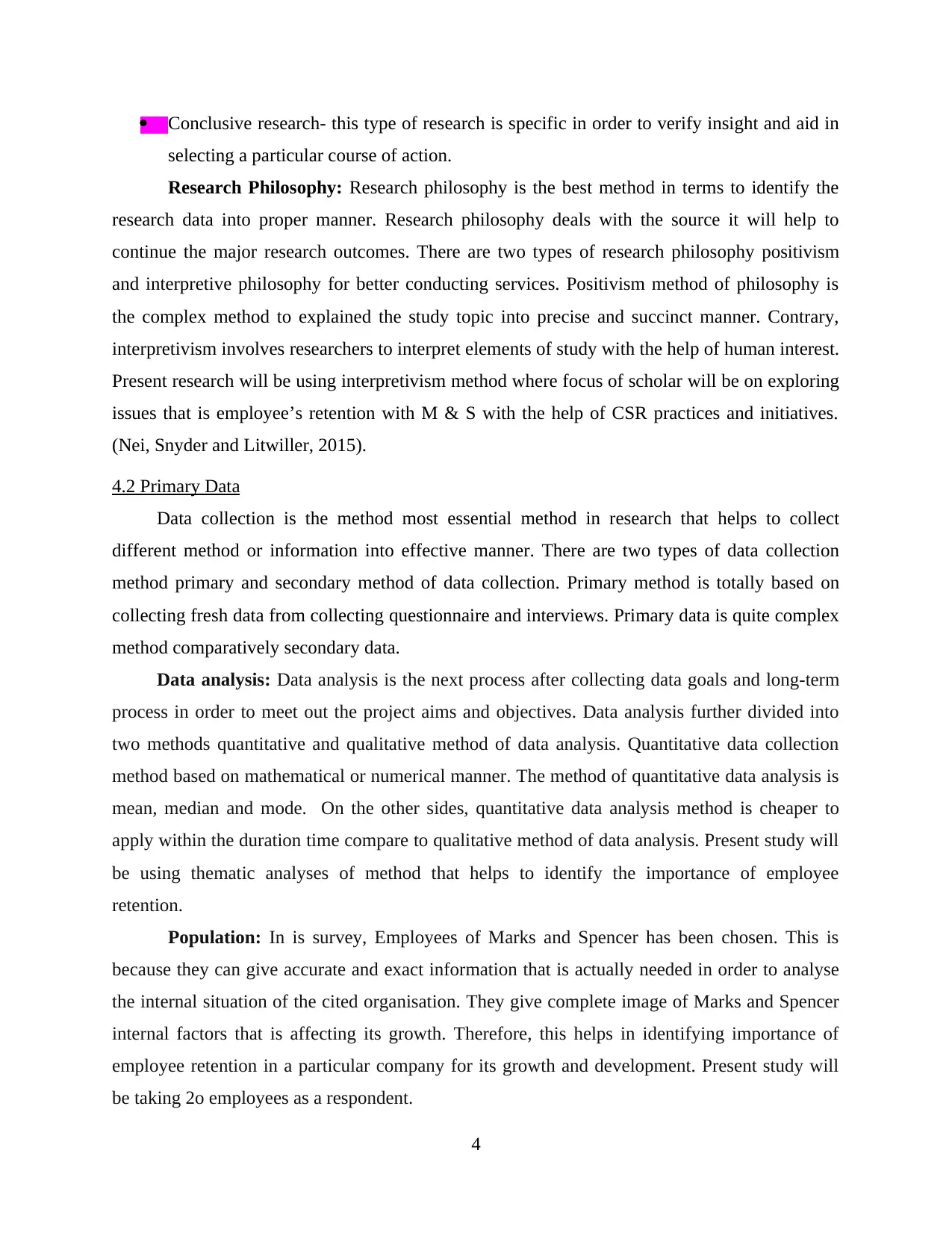
Conclusive research- this type of research is specific in order to verify insight and aid in
selecting a particular course of action.
Research Philosophy: Research philosophy is the best method in terms to identify the
research data into proper manner. Research philosophy deals with the source it will help to
continue the major research outcomes. There are two types of research philosophy positivism
and interpretive philosophy for better conducting services. Positivism method of philosophy is
the complex method to explained the study topic into precise and succinct manner. Contrary,
interpretivism involves researchers to interpret elements of study with the help of human interest.
Present research will be using interpretivism method where focus of scholar will be on exploring
issues that is employee’s retention with M & S with the help of CSR practices and initiatives.
(Nei, Snyder and Litwiller, 2015).
4.2 Primary Data
Data collection is the method most essential method in research that helps to collect
different method or information into effective manner. There are two types of data collection
method primary and secondary method of data collection. Primary method is totally based on
collecting fresh data from collecting questionnaire and interviews. Primary data is quite complex
method comparatively secondary data.
Data analysis: Data analysis is the next process after collecting data goals and long-term
process in order to meet out the project aims and objectives. Data analysis further divided into
two methods quantitative and qualitative method of data analysis. Quantitative data collection
method based on mathematical or numerical manner. The method of quantitative data analysis is
mean, median and mode. On the other sides, quantitative data analysis method is cheaper to
apply within the duration time compare to qualitative method of data analysis. Present study will
be using thematic analyses of method that helps to identify the importance of employee
retention.
Population: In is survey, Employees of Marks and Spencer has been chosen. This is
because they can give accurate and exact information that is actually needed in order to analyse
the internal situation of the cited organisation. They give complete image of Marks and Spencer
internal factors that is affecting its growth. Therefore, this helps in identifying importance of
employee retention in a particular company for its growth and development. Present study will
be taking 2o employees as a respondent.
4
selecting a particular course of action.
Research Philosophy: Research philosophy is the best method in terms to identify the
research data into proper manner. Research philosophy deals with the source it will help to
continue the major research outcomes. There are two types of research philosophy positivism
and interpretive philosophy for better conducting services. Positivism method of philosophy is
the complex method to explained the study topic into precise and succinct manner. Contrary,
interpretivism involves researchers to interpret elements of study with the help of human interest.
Present research will be using interpretivism method where focus of scholar will be on exploring
issues that is employee’s retention with M & S with the help of CSR practices and initiatives.
(Nei, Snyder and Litwiller, 2015).
4.2 Primary Data
Data collection is the method most essential method in research that helps to collect
different method or information into effective manner. There are two types of data collection
method primary and secondary method of data collection. Primary method is totally based on
collecting fresh data from collecting questionnaire and interviews. Primary data is quite complex
method comparatively secondary data.
Data analysis: Data analysis is the next process after collecting data goals and long-term
process in order to meet out the project aims and objectives. Data analysis further divided into
two methods quantitative and qualitative method of data analysis. Quantitative data collection
method based on mathematical or numerical manner. The method of quantitative data analysis is
mean, median and mode. On the other sides, quantitative data analysis method is cheaper to
apply within the duration time compare to qualitative method of data analysis. Present study will
be using thematic analyses of method that helps to identify the importance of employee
retention.
Population: In is survey, Employees of Marks and Spencer has been chosen. This is
because they can give accurate and exact information that is actually needed in order to analyse
the internal situation of the cited organisation. They give complete image of Marks and Spencer
internal factors that is affecting its growth. Therefore, this helps in identifying importance of
employee retention in a particular company for its growth and development. Present study will
be taking 2o employees as a respondent.
4
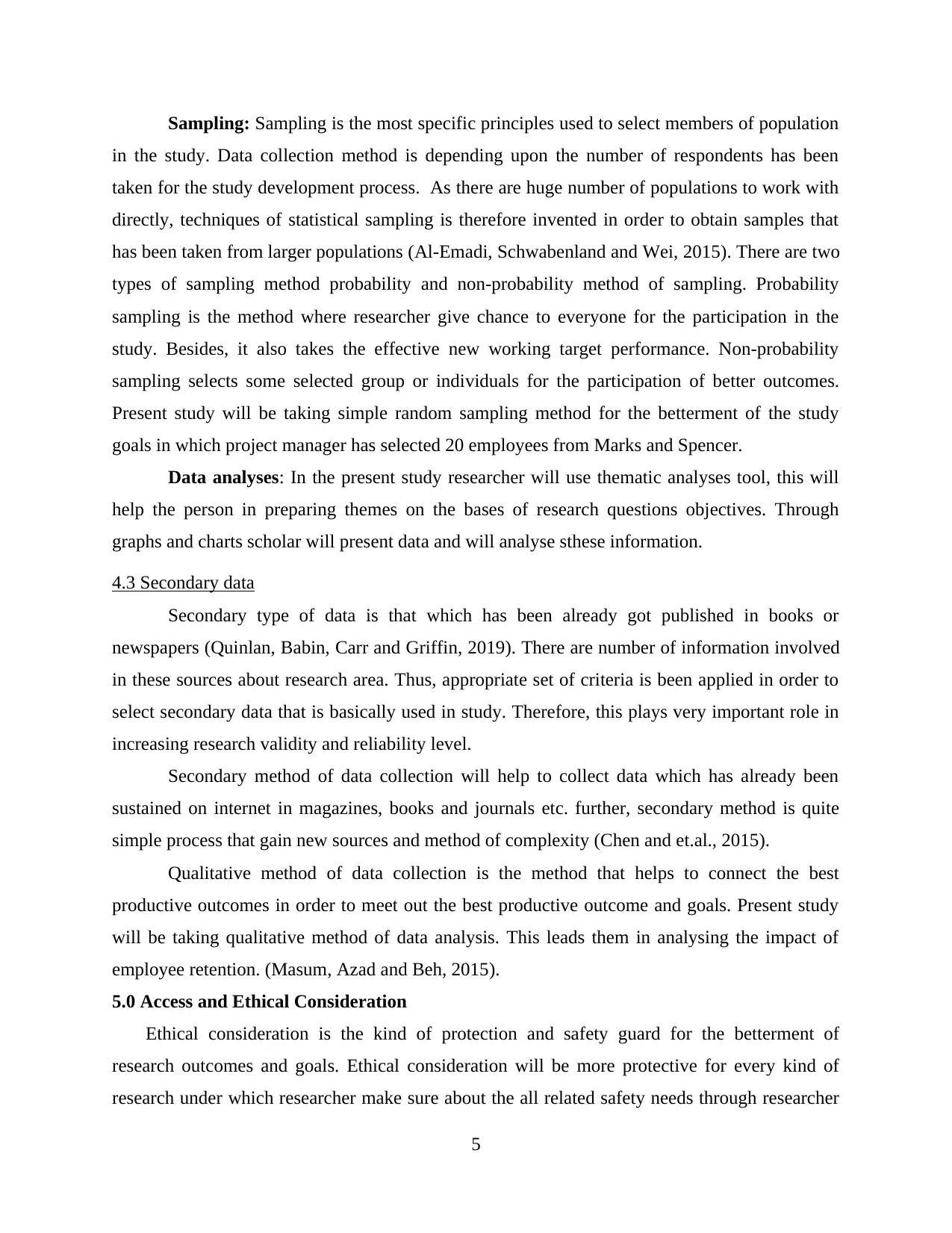
Sampling: Sampling is the most specific principles used to select members of population
in the study. Data collection method is depending upon the number of respondents has been
taken for the study development process. As there are huge number of populations to work with
directly, techniques of statistical sampling is therefore invented in order to obtain samples that
has been taken from larger populations (Al-Emadi, Schwabenland and Wei, 2015). There are two
types of sampling method probability and non-probability method of sampling. Probability
sampling is the method where researcher give chance to everyone for the participation in the
study. Besides, it also takes the effective new working target performance. Non-probability
sampling selects some selected group or individuals for the participation of better outcomes.
Present study will be taking simple random sampling method for the betterment of the study
goals in which project manager has selected 20 employees from Marks and Spencer.
Data analyses: In the present study researcher will use thematic analyses tool, this will
help the person in preparing themes on the bases of research questions objectives. Through
graphs and charts scholar will present data and will analyse sthese information.
4.3 Secondary data
Secondary type of data is that which has been already got published in books or
newspapers (Quinlan, Babin, Carr and Griffin, 2019). There are number of information involved
in these sources about research area. Thus, appropriate set of criteria is been applied in order to
select secondary data that is basically used in study. Therefore, this plays very important role in
increasing research validity and reliability level.
Secondary method of data collection will help to collect data which has already been
sustained on internet in magazines, books and journals etc. further, secondary method is quite
simple process that gain new sources and method of complexity (Chen and et.al., 2015).
Qualitative method of data collection is the method that helps to connect the best
productive outcomes in order to meet out the best productive outcome and goals. Present study
will be taking qualitative method of data analysis. This leads them in analysing the impact of
employee retention. (Masum, Azad and Beh, 2015).
5.0 Access and Ethical Consideration
Ethical consideration is the kind of protection and safety guard for the betterment of
research outcomes and goals. Ethical consideration will be more protective for every kind of
research under which researcher make sure about the all related safety needs through researcher
5
in the study. Data collection method is depending upon the number of respondents has been
taken for the study development process. As there are huge number of populations to work with
directly, techniques of statistical sampling is therefore invented in order to obtain samples that
has been taken from larger populations (Al-Emadi, Schwabenland and Wei, 2015). There are two
types of sampling method probability and non-probability method of sampling. Probability
sampling is the method where researcher give chance to everyone for the participation in the
study. Besides, it also takes the effective new working target performance. Non-probability
sampling selects some selected group or individuals for the participation of better outcomes.
Present study will be taking simple random sampling method for the betterment of the study
goals in which project manager has selected 20 employees from Marks and Spencer.
Data analyses: In the present study researcher will use thematic analyses tool, this will
help the person in preparing themes on the bases of research questions objectives. Through
graphs and charts scholar will present data and will analyse sthese information.
4.3 Secondary data
Secondary type of data is that which has been already got published in books or
newspapers (Quinlan, Babin, Carr and Griffin, 2019). There are number of information involved
in these sources about research area. Thus, appropriate set of criteria is been applied in order to
select secondary data that is basically used in study. Therefore, this plays very important role in
increasing research validity and reliability level.
Secondary method of data collection will help to collect data which has already been
sustained on internet in magazines, books and journals etc. further, secondary method is quite
simple process that gain new sources and method of complexity (Chen and et.al., 2015).
Qualitative method of data collection is the method that helps to connect the best
productive outcomes in order to meet out the best productive outcome and goals. Present study
will be taking qualitative method of data analysis. This leads them in analysing the impact of
employee retention. (Masum, Azad and Beh, 2015).
5.0 Access and Ethical Consideration
Ethical consideration is the kind of protection and safety guard for the betterment of
research outcomes and goals. Ethical consideration will be more protective for every kind of
research under which researcher make sure about the all related safety needs through researcher
5
⊘ This is a preview!⊘
Do you want full access?
Subscribe today to unlock all pages.

Trusted by 1+ million students worldwide
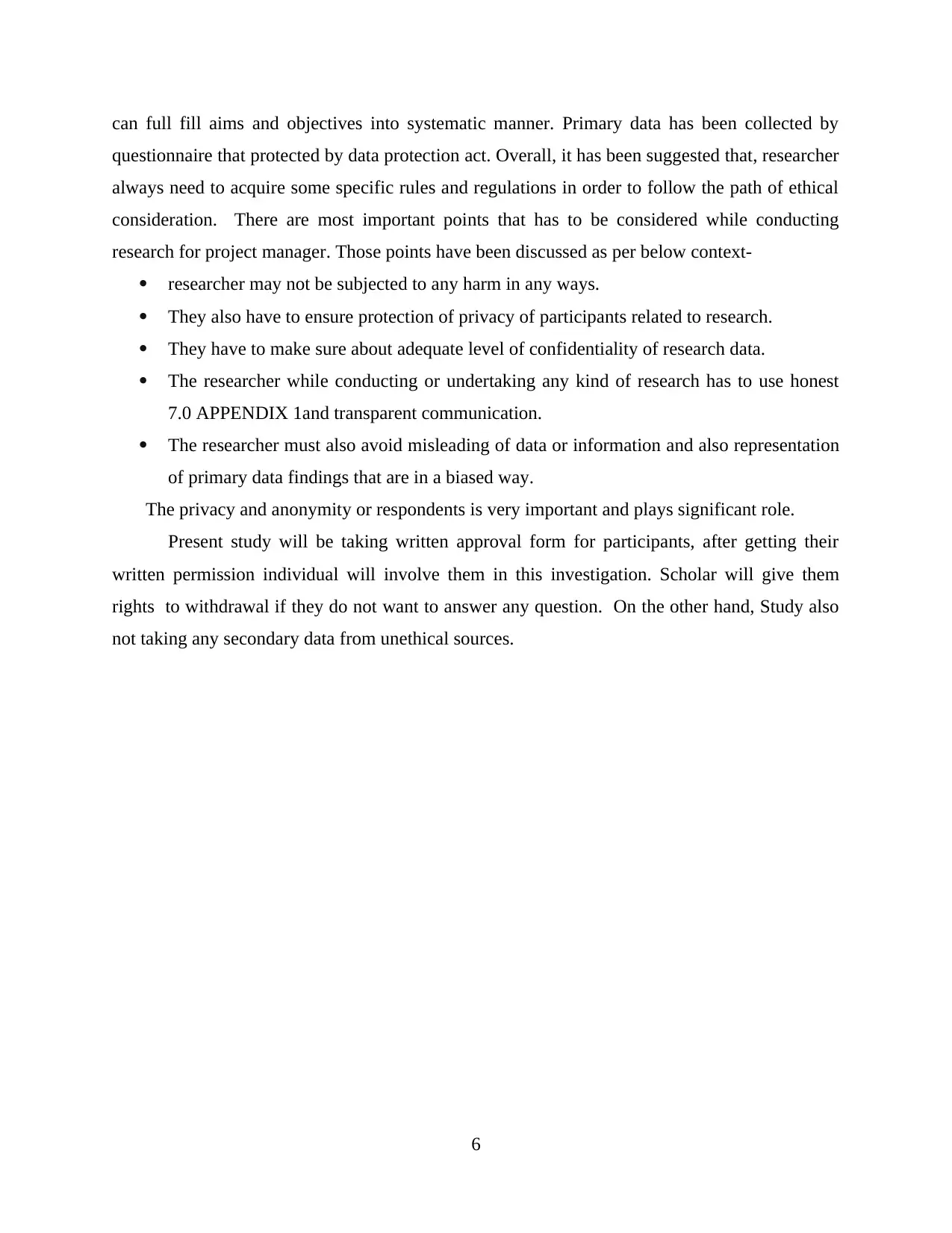
can full fill aims and objectives into systematic manner. Primary data has been collected by
questionnaire that protected by data protection act. Overall, it has been suggested that, researcher
always need to acquire some specific rules and regulations in order to follow the path of ethical
consideration. There are most important points that has to be considered while conducting
research for project manager. Those points have been discussed as per below context-
researcher may not be subjected to any harm in any ways.
They also have to ensure protection of privacy of participants related to research.
They have to make sure about adequate level of confidentiality of research data.
The researcher while conducting or undertaking any kind of research has to use honest
7.0 APPENDIX 1and transparent communication.
The researcher must also avoid misleading of data or information and also representation
of primary data findings that are in a biased way.
The privacy and anonymity or respondents is very important and plays significant role.
Present study will be taking written approval form for participants, after getting their
written permission individual will involve them in this investigation. Scholar will give them
rights to withdrawal if they do not want to answer any question. On the other hand, Study also
not taking any secondary data from unethical sources.
6
questionnaire that protected by data protection act. Overall, it has been suggested that, researcher
always need to acquire some specific rules and regulations in order to follow the path of ethical
consideration. There are most important points that has to be considered while conducting
research for project manager. Those points have been discussed as per below context-
researcher may not be subjected to any harm in any ways.
They also have to ensure protection of privacy of participants related to research.
They have to make sure about adequate level of confidentiality of research data.
The researcher while conducting or undertaking any kind of research has to use honest
7.0 APPENDIX 1and transparent communication.
The researcher must also avoid misleading of data or information and also representation
of primary data findings that are in a biased way.
The privacy and anonymity or respondents is very important and plays significant role.
Present study will be taking written approval form for participants, after getting their
written permission individual will involve them in this investigation. Scholar will give them
rights to withdrawal if they do not want to answer any question. On the other hand, Study also
not taking any secondary data from unethical sources.
6
Paraphrase This Document
Need a fresh take? Get an instant paraphrase of this document with our AI Paraphraser
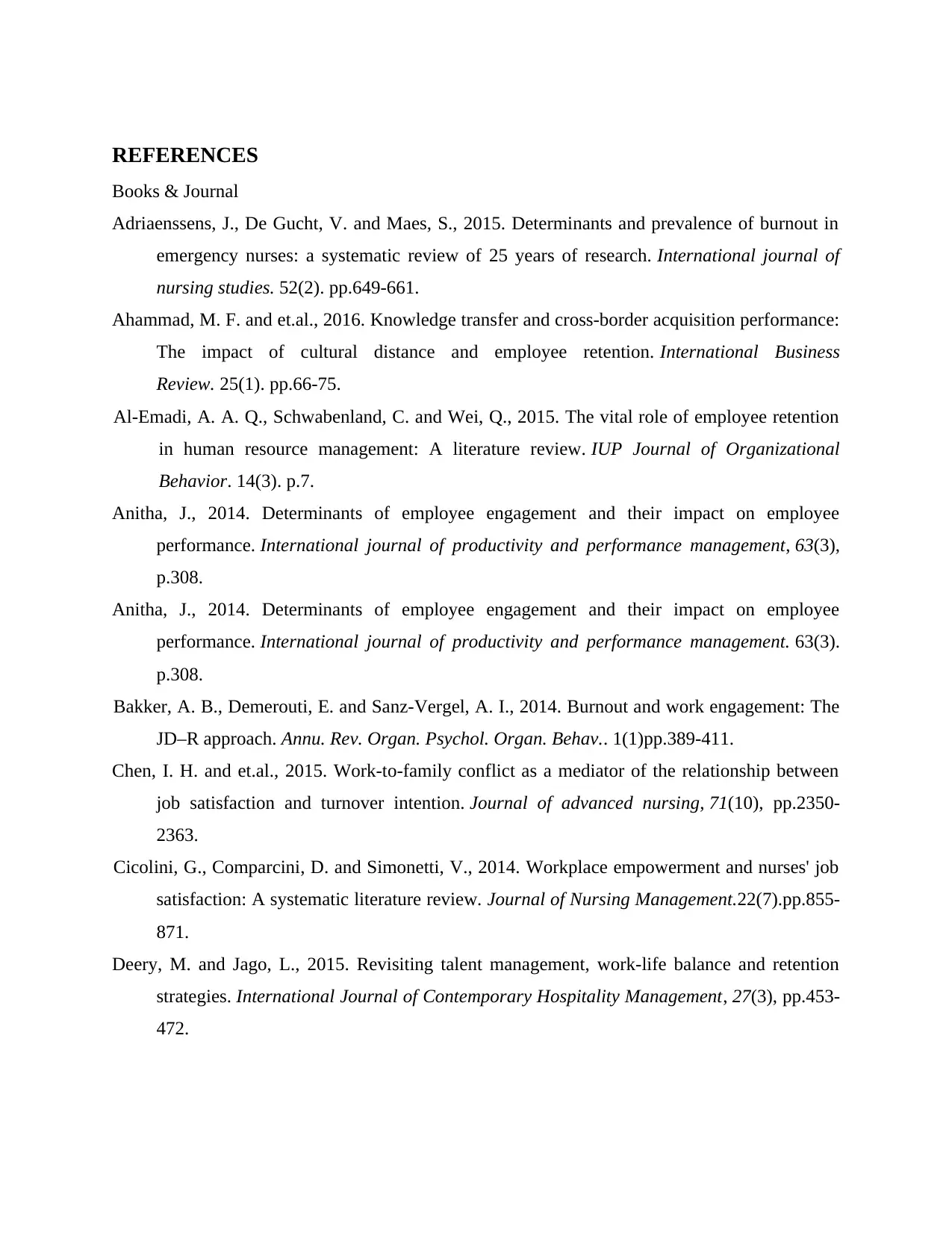
REFERENCES
Books & Journal
Adriaenssens, J., De Gucht, V. and Maes, S., 2015. Determinants and prevalence of burnout in
emergency nurses: a systematic review of 25 years of research. International journal of
nursing studies. 52(2). pp.649-661.
Ahammad, M. F. and et.al., 2016. Knowledge transfer and cross-border acquisition performance:
The impact of cultural distance and employee retention. International Business
Review. 25(1). pp.66-75.
Al-Emadi, A. A. Q., Schwabenland, C. and Wei, Q., 2015. The vital role of employee retention
in human resource management: A literature review. IUP Journal of Organizational
Behavior. 14(3). p.7.
Anitha, J., 2014. Determinants of employee engagement and their impact on employee
performance. International journal of productivity and performance management, 63(3),
p.308.
Anitha, J., 2014. Determinants of employee engagement and their impact on employee
performance. International journal of productivity and performance management. 63(3).
p.308.
Bakker, A. B., Demerouti, E. and Sanz-Vergel, A. I., 2014. Burnout and work engagement: The
JD–R approach. Annu. Rev. Organ. Psychol. Organ. Behav.. 1(1)pp.389-411.
Chen, I. H. and et.al., 2015. Work‐to‐family conflict as a mediator of the relationship between
job satisfaction and turnover intention. Journal of advanced nursing, 71(10), pp.2350-
2363.
Cicolini, G., Comparcini, D. and Simonetti, V., 2014. Workplace empowerment and nurses' job
satisfaction: A systematic literature review. Journal of Nursing Management.22(7).pp.855-
871.
Deery, M. and Jago, L., 2015. Revisiting talent management, work-life balance and retention
strategies. International Journal of Contemporary Hospitality Management, 27(3), pp.453-
472.
Books & Journal
Adriaenssens, J., De Gucht, V. and Maes, S., 2015. Determinants and prevalence of burnout in
emergency nurses: a systematic review of 25 years of research. International journal of
nursing studies. 52(2). pp.649-661.
Ahammad, M. F. and et.al., 2016. Knowledge transfer and cross-border acquisition performance:
The impact of cultural distance and employee retention. International Business
Review. 25(1). pp.66-75.
Al-Emadi, A. A. Q., Schwabenland, C. and Wei, Q., 2015. The vital role of employee retention
in human resource management: A literature review. IUP Journal of Organizational
Behavior. 14(3). p.7.
Anitha, J., 2014. Determinants of employee engagement and their impact on employee
performance. International journal of productivity and performance management, 63(3),
p.308.
Anitha, J., 2014. Determinants of employee engagement and their impact on employee
performance. International journal of productivity and performance management. 63(3).
p.308.
Bakker, A. B., Demerouti, E. and Sanz-Vergel, A. I., 2014. Burnout and work engagement: The
JD–R approach. Annu. Rev. Organ. Psychol. Organ. Behav.. 1(1)pp.389-411.
Chen, I. H. and et.al., 2015. Work‐to‐family conflict as a mediator of the relationship between
job satisfaction and turnover intention. Journal of advanced nursing, 71(10), pp.2350-
2363.
Cicolini, G., Comparcini, D. and Simonetti, V., 2014. Workplace empowerment and nurses' job
satisfaction: A systematic literature review. Journal of Nursing Management.22(7).pp.855-
871.
Deery, M. and Jago, L., 2015. Revisiting talent management, work-life balance and retention
strategies. International Journal of Contemporary Hospitality Management, 27(3), pp.453-
472.
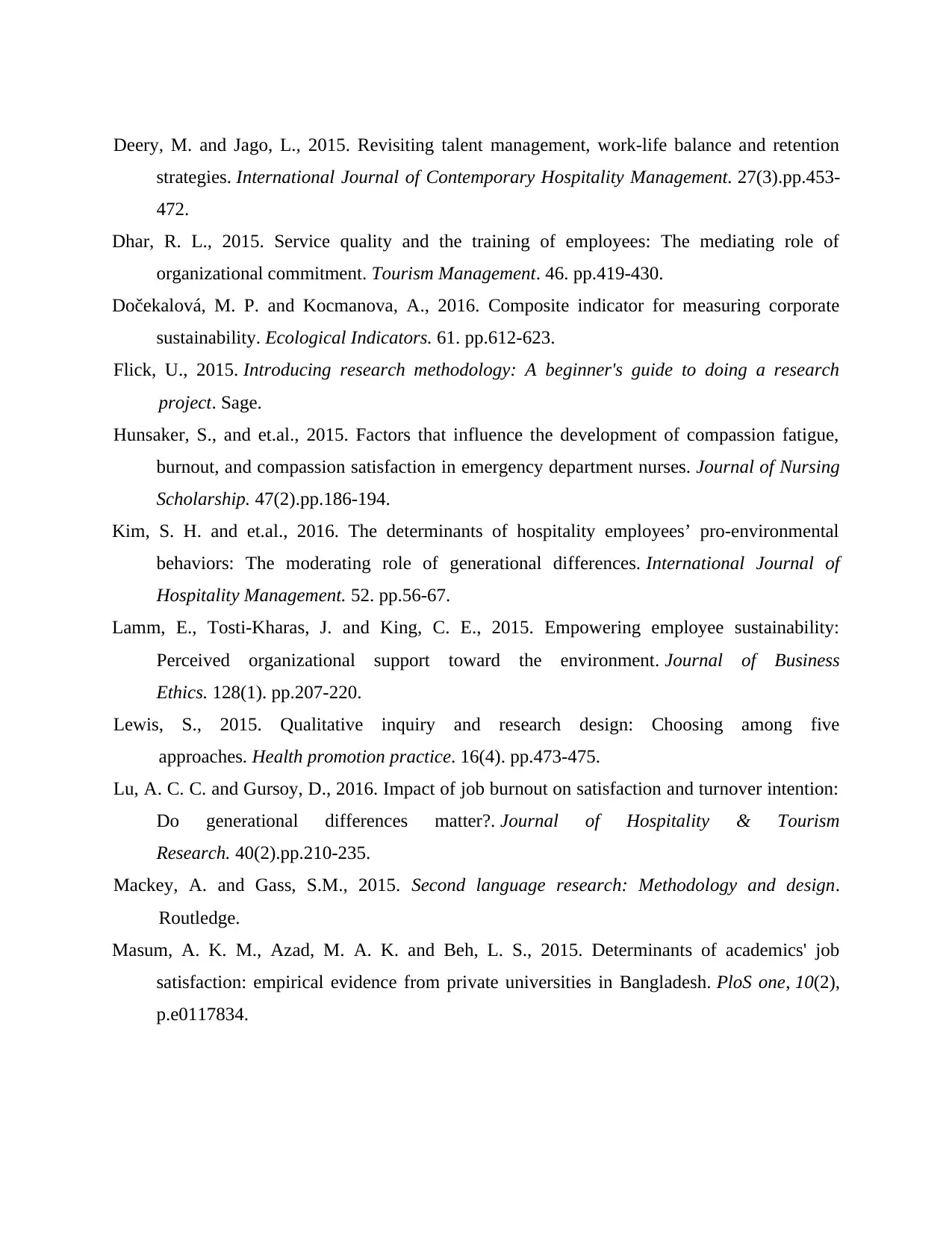
Deery, M. and Jago, L., 2015. Revisiting talent management, work-life balance and retention
strategies. International Journal of Contemporary Hospitality Management. 27(3).pp.453-
472.
Dhar, R. L., 2015. Service quality and the training of employees: The mediating role of
organizational commitment. Tourism Management. 46. pp.419-430.
Dočekalová, M. P. and Kocmanova, A., 2016. Composite indicator for measuring corporate
sustainability. Ecological Indicators. 61. pp.612-623.
Flick, U., 2015. Introducing research methodology: A beginner's guide to doing a research
project. Sage.
Hunsaker, S., and et.al., 2015. Factors that influence the development of compassion fatigue,
burnout, and compassion satisfaction in emergency department nurses. Journal of Nursing
Scholarship. 47(2).pp.186-194.
Kim, S. H. and et.al., 2016. The determinants of hospitality employees’ pro-environmental
behaviors: The moderating role of generational differences. International Journal of
Hospitality Management. 52. pp.56-67.
Lamm, E., Tosti-Kharas, J. and King, C. E., 2015. Empowering employee sustainability:
Perceived organizational support toward the environment. Journal of Business
Ethics. 128(1). pp.207-220.
Lewis, S., 2015. Qualitative inquiry and research design: Choosing among five
approaches. Health promotion practice. 16(4). pp.473-475.
Lu, A. C. C. and Gursoy, D., 2016. Impact of job burnout on satisfaction and turnover intention:
Do generational differences matter?. Journal of Hospitality & Tourism
Research. 40(2).pp.210-235.
Mackey, A. and Gass, S.M., 2015. Second language research: Methodology and design.
Routledge.
Masum, A. K. M., Azad, M. A. K. and Beh, L. S., 2015. Determinants of academics' job
satisfaction: empirical evidence from private universities in Bangladesh. PloS one, 10(2),
p.e0117834.
strategies. International Journal of Contemporary Hospitality Management. 27(3).pp.453-
472.
Dhar, R. L., 2015. Service quality and the training of employees: The mediating role of
organizational commitment. Tourism Management. 46. pp.419-430.
Dočekalová, M. P. and Kocmanova, A., 2016. Composite indicator for measuring corporate
sustainability. Ecological Indicators. 61. pp.612-623.
Flick, U., 2015. Introducing research methodology: A beginner's guide to doing a research
project. Sage.
Hunsaker, S., and et.al., 2015. Factors that influence the development of compassion fatigue,
burnout, and compassion satisfaction in emergency department nurses. Journal of Nursing
Scholarship. 47(2).pp.186-194.
Kim, S. H. and et.al., 2016. The determinants of hospitality employees’ pro-environmental
behaviors: The moderating role of generational differences. International Journal of
Hospitality Management. 52. pp.56-67.
Lamm, E., Tosti-Kharas, J. and King, C. E., 2015. Empowering employee sustainability:
Perceived organizational support toward the environment. Journal of Business
Ethics. 128(1). pp.207-220.
Lewis, S., 2015. Qualitative inquiry and research design: Choosing among five
approaches. Health promotion practice. 16(4). pp.473-475.
Lu, A. C. C. and Gursoy, D., 2016. Impact of job burnout on satisfaction and turnover intention:
Do generational differences matter?. Journal of Hospitality & Tourism
Research. 40(2).pp.210-235.
Mackey, A. and Gass, S.M., 2015. Second language research: Methodology and design.
Routledge.
Masum, A. K. M., Azad, M. A. K. and Beh, L. S., 2015. Determinants of academics' job
satisfaction: empirical evidence from private universities in Bangladesh. PloS one, 10(2),
p.e0117834.
⊘ This is a preview!⊘
Do you want full access?
Subscribe today to unlock all pages.

Trusted by 1+ million students worldwide
1 out of 39
Related Documents
Your All-in-One AI-Powered Toolkit for Academic Success.
+13062052269
info@desklib.com
Available 24*7 on WhatsApp / Email
![[object Object]](/_next/static/media/star-bottom.7253800d.svg)
Unlock your academic potential
Copyright © 2020–2025 A2Z Services. All Rights Reserved. Developed and managed by ZUCOL.




